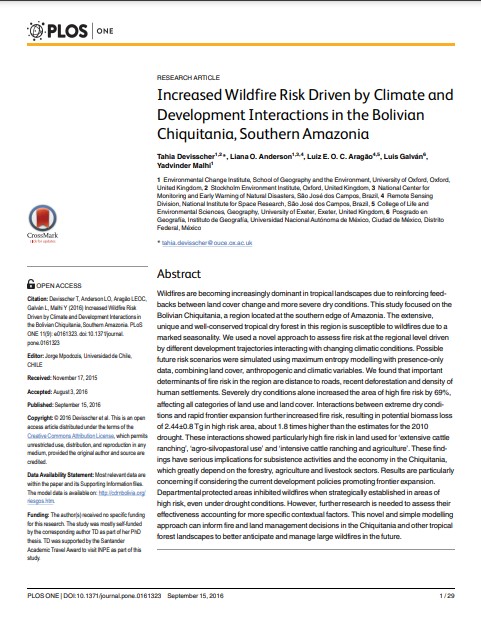Increased wildfire risk driven by climate and development interactions in the Bolivian Chiquitania, Southern Amazonia
Bosque Modelo:
Chiquitano
Temática:
Conservación
Tipo de documento:
Artículo científico
Resumen
Wildfires are becoming increasingly dominant in tropical landscapes due to reinforcing feedbacks between land cover change and more severe dry conditions. This study focused on the Bolivian Chiquitania, a region located at the southern edge of Amazonia. The extensive, unique and well-conserved tropical dry forest in this region is susceptible to wildfires due to a marked seasonality. We used a novel approach to assess fire risk at the regional level driven by different development trajectories interacting with changing climatic conditions. Possible future risk scenarios were simulated using maximum entropy modelling with presence-only data, combining land cover, anthropogenic and climatic variables. We found that important determinantsof fire risk in the region are distance to roads, recent deforestation and density of human settlements. Severely dry conditions alone increased the area of high fire risk by 69%, affecting all categories of land use and land cover. Interactions between extreme dry conditions and rapid frontier expansion furtherincreased fire risk, resulting in potential biomass loss of 2.44±0.8 Tg in high risk area, about 1.8 times higher than the estimates for the 2010 drought. These interactions showed particularlyhigh fire risk in land used for ‘extensive cattle ranching’, ‘agro-silvopastoral use’ and ‘intensive cattle ranching and agriculture’.These findings have serious implications for subsistence activities and the economy in the Chiquitania, which greatly depend on the forestry, agriculture and livestock sectors. Results are particularly concerning if considering the current development policies promoting frontier expansion. Departmentalprotected areas inhibited wildfires when strategically established in areas of high risk, even under drought conditions. However, furtherresearch is needed to assess their effectiveness accounting for more specific contextual factors. This novel and simple modelling approach can inform fire and land management decisions in the Chiquitania and other tropical forest landscapes to better anticipate and manage large wildfires in the future.
Información Bibliográfica
Autor:
Tahia Devisscher, Liana O Anderson, Luiz EOC Aragão, Luis Galván, Yadvinder Malhi
Revista:
Public Library of Science San Francisco, CA USA
Año:
2016
N°:
-
País :
Bolivia
Páginas:
-
Volumen:
11
Idioma:
Ingles
Palabras claves
Wildfire, impact





